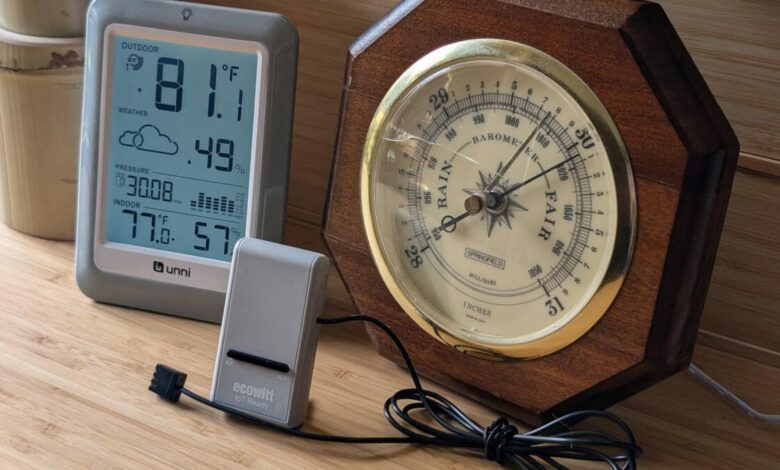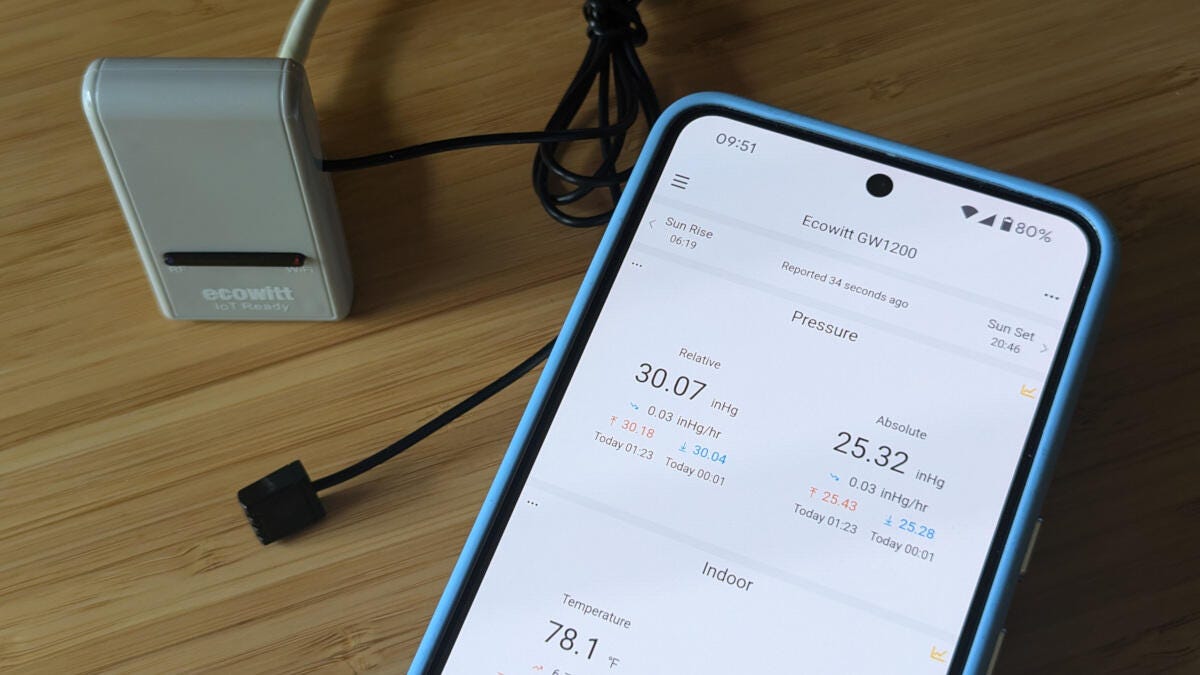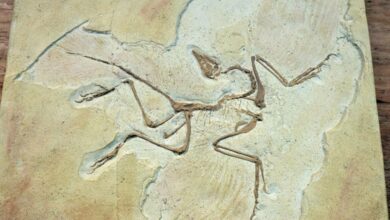Barometers are an underrated technology for DIY weather forecasting







I first learned about the effect of atmospheric pressure on the weather as a child during a summer science project. It included making an aneroid barometer with a balloon, pencil and empty jar. As the season turned to fall, I became obsessed with the pencil’s responses to daily weather patterns and gradually learned how to predict impending bad weather.
Eventually my haphazard barometer broke and I didn’t feel like making a new one. Still, the experience of predicting my weather conditions stuck with me. A dial barometer from a local thrift store has been one of my favorite gadgets for years, even though it’s worn out.
Let’s take a closer look at barometers and why you might need one.
What is a barometer?

I usually check the barometer before I start my day.
A barometer is a simple sensor that measures atmospheric pressure. If you want to get more technical, barometers and weather apps in the US typically display atmospheric pressure in inches of mercury.
Organizations that focus on meteorology, such as the National Weather Service also list a metric measurement in millibars or hectopascals. Hectopascals are equivalent to millibars — no unit conversion needed — my Unni weather station shows both.
Any of these units are suitable for everyday use, but I still recommend using the option that matches your favorite weather app.
According to the National Oceanic and Atmospheric AdministrationThe numbers displayed on a barometer come from the standard air pressure at sea level:
- 29.92 inches of mercury
- 1013.25 millibar/hectopascal
When the air pressure is below normal, there is usually stormy weather. When the pressure rises, the sun shines.
How do you read a barometer?

To get an accurate reading on an aneroid barometer, tap the center of the dial gently. Often the needle needs help to overcome friction.
By looking for noticeable fluctuations in air pressure, you can often predict what the weather will be like in the coming hours. That’s why most barometers allow you to see previous readings. You can expect more clouds and possibly stormy weather when the pressure is low. High pressure, on the other hand, means more sunshine and drier air.
If you hear the wind howling, it is a good time to check your barometric readings. Wind usually accompanies pressure changes, as a low pressure area gives way to a high pressure area, and vice versa.
Once you have a basic understanding of this scientific instrument, it is a matter of taking mental or written notes about changes in the weather. You will begin to recognize patterns and the weather conditions that create them.
It’s a good idea to check the barometer reading before you leave home so you know whether to throw an umbrella in your backpack. You can also take a portable unit to help you decide if those dark clouds are going to ruin your next hike or day on the lake. Consider checking your phone’s specs to see if it has a built-in barometer that you can try with a barometer app on iOS or Android.
Calibrating your barometer

Barometers cannot match the accuracy of computer-based weather forecasts, but are indispensable for basic forecasting and identifying local precipitation trends.
Barometers need to be calibrated during installation to match your local weather station. This is because air pressure changes based on your altitude relative to sea level. Since there is less atmosphere at higher altitudes, they experience lower air pressure. Calibration compensates for the altitude difference and aligns your barometer with the station’s pressure.
The easiest way to find this information is to enter your zip code at weather.gov. Alternatively, most weather apps display the pressure. Weather station user manuals should include installation instructions, but a online calibration guide is also useful.
- Analog barometers have an adjustment screw on the back that can be turned with a small screwdriver.
- Digital barometers usually have automatic calibration, but have buttons on the back of the device for quick corrections.
- Some internet connected barometers require an offset setting to match the local weather station pressure. You can calculate the offset by subtracting the current reading from your barometer from the online station pressure.
What type of barometer should you buy?

Historical barometric data allows you to see trends and better predict future weather.
Regardless of the type, buy a barometer or weather station that keeps at least one previous air pressure reading. For analog barometers, look for a trend needle that you can turn. Digital barometers should show a bar graph or arrow that shows recent pressure changes. Otherwise, you should write down or memorize previous readings.
Analogue weather stations, such as the Environmental weather YG315 And Mavoriare great for beginners because they are easy to read and the traditional design looks great in most homes. They also provide temperature and humidity readings.
Still, you may have to wade through a sea of aneroid barometer product pages to find your preferred unit of measure. Some even display millimeters of mercury, which is more useful for blood pressure monitors than for weather stations.

One advantage of aneroid barometers over digital models is that they do not require batteries.
While analog barometers work well enough for day-to-day weather observations, electronic barometers are more reliable, and the precise measurements are perfect for amateur meteorologists. Choosing a digital weather station depends on your screen preference and the conditions you want to measure.
Bright, monochrome LCDs are great for visibility, as found on the Unni UN0585with or without backlight. However, you may want a full-color, backlit display to see the barometric reading from further away, such as the La Crosse Technology S84107-INT.
In addition to the display type, you can upgrade to a digital barometer model with more outdoor sensors for precipitation, wind speed, wind direction, dew point, and solar radiation. Wind measurements can provide more context for your barometer, as drastic pressure changes and strong winds are the same. Keep in mind that additional sensors can increase the price.

The Ecowitt GW1200 features a long-term data tracking system that is an excellent tool for amateur meteorology.
There are also options with Wi-Fi connections, mobile apps and the ability to share weather data with services such as Underground weather. I recently had a Ecowitt GW1200 that I want to integrate with my home automation system. I plan to add more sensors as my needs change.
A barometer’s ability to display atmospheric pressure trends makes it a great addition to any home weather station. It can help you learn the weather patterns in your area and give you insight into what to expect when clouds appear on the horizon. Best of all, it can spark a lifelong interest in meteorology as a hobby. That’s reason enough to get one.




